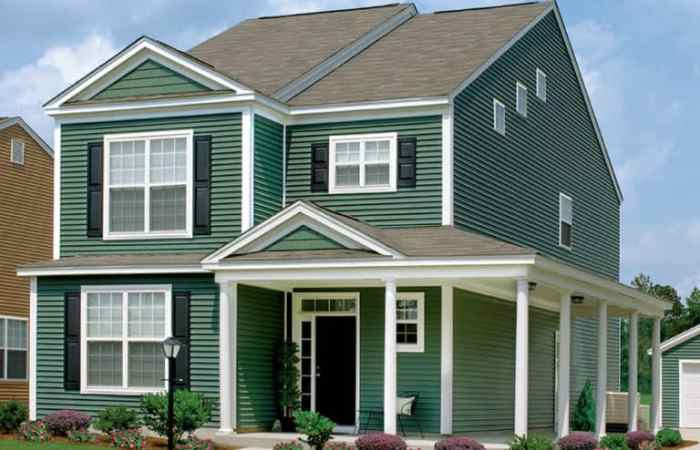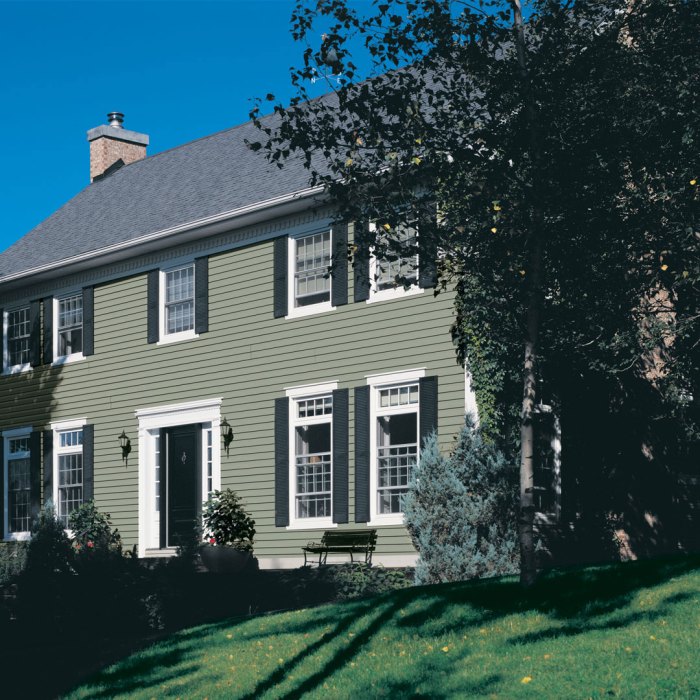Exploring the World of Green Exterior Siding
Step into the realm of green exterior siding, where sustainable materials meet style and functionality. From different types to installation tips, this article is your guide to creating an eco-friendly and visually appealing home exterior.
Dive deeper into the benefits, installation process, maintenance tips, and design options of green exterior siding for a comprehensive understanding of this eco-conscious choice.
Types of Green Exterior Siding

When it comes to green exterior siding, there are several types of materials to choose from. Each material comes with its own set of advantages and considerations, including durability, maintenance requirements, and environmental impact.
Wood Siding
Wood siding is a popular choice for green exterior siding due to its natural look and sustainability. However, wood siding requires regular maintenance, such as painting or staining, to protect it from the elements. While wood siding can be durable, it may be prone to rot or termite damage if not properly maintained.
From an environmental perspective, wood siding is biodegradable and renewable, making it a more eco-friendly option compared to other materials.
Fiber Cement Siding
Fiber cement siding is a durable and low-maintenance option for green exterior siding. It is resistant to rot, fire, and pests, making it a long-lasting choice for homeowners. Fiber cement siding typically requires less maintenance compared to wood siding, as it does not need to be painted as often.
While the production of fiber cement siding involves energy-intensive processes, it is considered a sustainable material due to its longevity and low maintenance requirements.
Recycled or Reclaimed Siding
Using recycled or reclaimed materials for exterior siding is a sustainable option that reduces waste and minimizes environmental impact. Recycled or reclaimed siding can be made from a variety of materials, such as wood, metal, or plastic, giving homeowners a unique and eco-friendly choice for their homes.
While the durability of recycled siding may vary depending on the material used, it can provide a distinctive look while promoting sustainability and reducing the carbon footprint of the construction industry.
Benefits of Green Exterior Siding
Green exterior siding offers a range of benefits that go beyond just aesthetics. One of the key advantages of using green siding materials is the enhanced energy efficiency they provide for homes.
Energy Efficiency
Green exterior siding is designed to help regulate indoor temperatures by providing better insulation for homes. This means that during hot summers, the siding helps keep the interior cooler by reducing heat transfer from the outside. Similarly, in cold winters, the siding helps trap heat inside, reducing the need for excessive heating.
This improved energy efficiency can lead to lower utility bills and a smaller carbon footprint.
Improved Insulation
Green siding materials are often manufactured with insulation properties that can help improve the overall energy efficiency of a home. By reducing heat transfer through walls, green siding can help maintain a comfortable indoor temperature without overworking heating and cooling systems.
This can result in a more consistent and comfortable living environment for homeowners.
Long-term Cost Savings
While the initial cost of installing green exterior siding may be higher than traditional siding materials, the long-term cost savings can outweigh the upfront investment. With reduced energy consumption and lower utility bills, homeowners can save money over the years.
Additionally, the durability of green siding materials can result in less maintenance and replacement costs compared to traditional siding options, making it a cost-effective choice in the long run.
Installation of Green Exterior Siding

Installing green exterior siding can enhance the aesthetic appeal of your home while providing environmental benefits. Here is a step-by-step guide to help you with the installation process.
Gather the Necessary Tools and Materials
- Green exterior siding panels
- Nails or screws
- Hammer or screw gun
- Tape measure
- Level
- Saw
- Caulk and caulking gun
- House wrap
- Corner pieces
- Trim pieces
Prepare the Surface
Before installing the green exterior siding, make sure the surface is clean, dry, and free from any debris. Install house wrap to provide additional insulation and protection against moisture.
Install the Siding Panels
- Measure and cut the siding panels to fit the dimensions of your exterior walls.
- Starting from the bottom of the wall, attach the first panel using nails or screws. Make sure it is level.
- Overlap the next panel with the previous one and secure it in place. Repeat this process until the entire wall is covered.
- Install corner pieces and trim pieces to give a finished look to the edges and corners of the siding.
Finishing Touches
Ensure to caulk around windows, doors, and any openings to prevent water infiltration
.
Inspect the siding for any gaps or loose panels and make necessary adjustments for a seamless finish.
Maintenance and Care of Green Exterior Siding
Proper maintenance is essential to keep your green exterior siding in top condition. By following a regular maintenance schedule and addressing any issues promptly, you can extend the lifespan of your siding and keep your home looking beautiful.
Regular Cleaning
Regular cleaning is crucial to prevent the buildup of dirt, grime, and mold on your green exterior siding. Different types of siding may require slightly different cleaning methods, but a gentle approach is generally recommended to avoid damaging the finish.
- For vinyl siding, a mixture of water and mild soap can be used to clean the surface. Rinse thoroughly with a garden hose.
- Fiber cement siding can be cleaned with a solution of water and mild detergent. Avoid using abrasive cleaners or tools that could scratch the surface.
- Wood siding should be cleaned with a solution of water and a wood-safe cleaner. Be sure to rinse well and avoid letting the wood stay wet for extended periods.
Addressing Common Issues
Despite regular maintenance, green exterior siding may still encounter common issues that need to be addressed promptly to prevent further damage.
- Mold and Mildew:If you notice mold or mildew growth on your siding, use a solution of water and bleach to clean the affected areas. Wear protective gear and follow safety guidelines.
- Fading:Over time, green siding may fade due to exposure to sunlight. To restore the color, consider painting or staining the siding with a UV-resistant finish.
- Rot:Wood siding is particularly susceptible to rot. Inspect your siding regularly for signs of rot and replace any damaged boards to prevent further decay.
Design and Aesthetics with Green Exterior Siding

Green exterior siding offers a wide range of design options and styles to enhance the curb appeal of any home. The color green can evoke feelings of tranquility, nature, and harmony, making it a popular choice for many homeowners looking to add a touch of personality to their exteriors.
Exploring Design Options
When it comes to green exterior siding, there are various shades and tones to choose from, ranging from soft pastels to deep forest greens. Lighter shades of green can create a fresh and welcoming look, while darker hues can add drama and sophistication to the facade of a house.
- Consider using sage green for a subtle and earthy vibe.
- Opt for olive green for a more traditional and timeless appearance.
- Choose emerald green for a bold and modern statement.
Choosing the Right Shade
Selecting the right shade of green for your home's exterior depends on the architectural style and surrounding landscape. It is essential to consider the existing elements such as the roof color, trim, and surroundings to ensure a cohesive and harmonious look.
- For a rustic or farmhouse style, earthy greens like moss or fern can complement the natural surroundings.
- If you have a contemporary home, opt for a bold shade of green like teal or mint to create a striking contrast.
- In coastal areas, pale shades of green such as seafoam or aqua can evoke a serene and beachy atmosphere.
Complementing Architectural Styles
Green exterior siding can complement various architectural styles, adding character and charm to different types of homes. Whether you have a traditional colonial, a modern farmhouse, or a mid-century bungalow, green siding can be versatile enough to adapt to different aesthetics.
- Pair olive green siding with white trim for a classic colonial look.
- Combine dark green siding with stone accents for a rustic and cozy cabin feel.
- Use mint green siding with black details for a chic and contemporary appearance.
Closure
As we conclude our journey through the realm of green exterior siding, remember that sustainability and style can go hand in hand. Make informed choices for your home's exterior to enjoy long-term benefits for both your wallet and the environment.
Top FAQs
How does green exterior siding contribute to energy efficiency?
Green exterior siding provides better insulation, reducing the need for heating or cooling systems and ultimately lowering energy consumption.
What are some common issues that may arise with green siding?
Issues like mold growth or warping can occur if proper maintenance is not carried out regularly. Cleaning and inspections are key to avoiding these problems.
Can green siding be customized to fit different architectural styles?
Yes, green siding comes in various styles and shades, allowing homeowners to choose options that complement their specific architectural preferences.




